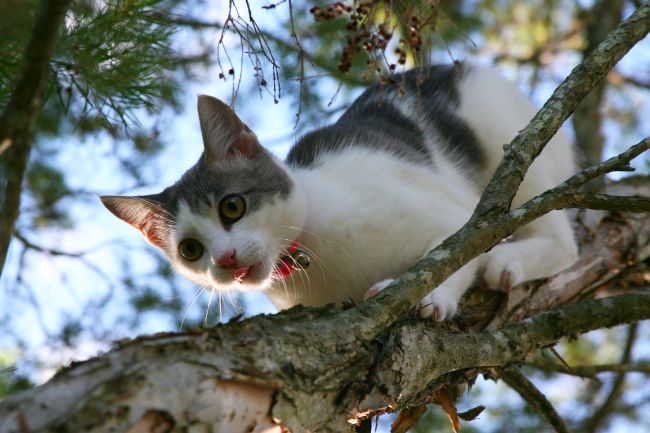
Do cats really get stuck in trees, or is that just a silly wives’ tale? Many cat owners have found their felines caught in high branches with no ability to get down, and have called upon heroic firemen for help. The occurrence of this kind of situation happens so frequently, that entire support groups and organizations are dedicated to helping rescue cats in such a predicament.
Why do cats get stuck?
The old saying “curiosity killed the cat” isn’t far off the mark. When left outside, cats often see an object in the distance that catches their fancy, such a bird sitting on a branch, or a bit of ribbon, string, or balloon caught on a twig that may be blowing in the wind. Whatever first attracted the kitty to the tree, may have been easy enough to get to, but it doesn’t follow that the pet will always be able to find a way back down. After all, climbing up a tree trunk is far easier than shimming down one. If a cat is left in a tree over night, he is in danger of getting hurt by another animal, and could suffer dehydration or injuries. When a cat is genuinely stuck, leaving him to come down by himself may not be a safe or realistic option.
How to rescue the cat
There are usually two kinds of treed cats: those that are situated among the boughs for their own devices, and able to find a way down; or those that are petrified with fear and uncertain how to escape. The latter can be dangerous to approach, as terrified cats have been known to tangle their rescuers up in a flurry of scratching paws. In order to avoid damage to your hands and face, and keep the cat from becoming more frightened, below are some basic tips for how to get the feline get back on solid ground.
- Give the cat enough time. Be certain that the cat indeed does need your help. In some cases, adept felines are perfectly capable of coming down from the tree themselves. A cat moving nimbly about from branch to branch, or sitting coolly perched in an apparent calm, will likely return of his own accord in an hour or two. (Try this theory by setting a bowl of his favorite food in plain view where he sits in the tree, then call his name. If that doesn’t budge the cat, it might be a sign that he doesn’t know how to get back.) If the kitty is up in a tree meowing desperately for a long time, and showing signs of anxiety and confusion; it is time to take action.
- Put on thick gloves. If you are attempting to rescue the cat alone, protect your hands and arms from claws by wearing thick coverings and long sleeves.
- Grab the back of the neck. This is not a hostile hold, but rather the caring clasp that the mother cat uses to transport her young. Not only is this painless, but felines often go limp in this position, making it easier to move them from the tree.
- Work quickly. Approaching slowly and swinging repeatedly at your cat (by using a broom or pole to try and get him down) may only further scare the animal, causing him to seek refuge higher up in the tree. This will only make the retrieval more difficult; so try to make your first rescue attempt a successful one.
- When all else fails, call for help. Many a frustrated cat owner has had to call the humane society for help in getting the cat down. If you can’t get your cat down, the professionals will!
Keeping cats out of trees
Avoid facing the same problem in the future by creating obstacles at the base of the tree so that it will be harder to climb. Some people wrap the tree trunk with thick wire fencing or a metal cone to disable the cat from being able to advance up the tree by using his claws.
Other owners have nailed small wooden planks into the tree, so that if their cat should ever get stuck again, he will be able to have a sturdy board stair-case to grab onto or stand on for support while descending.
Whatever happens, just remember that your tree-climbing cat was not the first to get trapped in a sea of leaves and branches, and he certainly won’t be the last to escape from them either.

